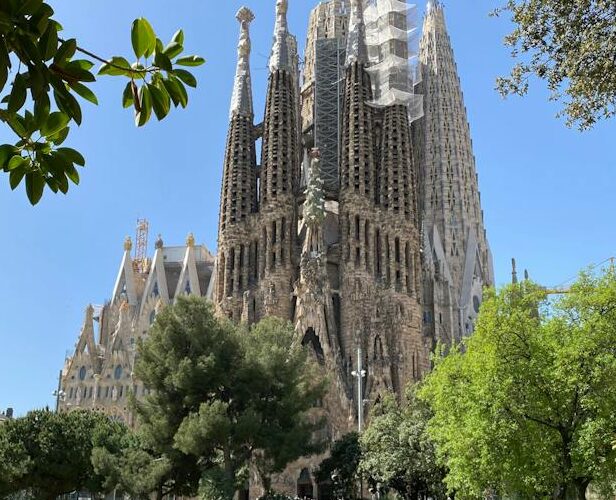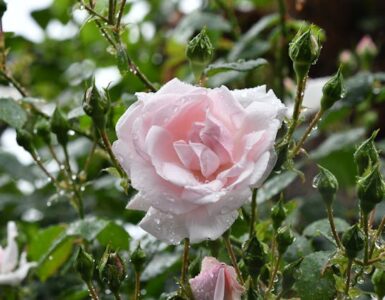For anyone visiting Barcelona in Spain, apart from the beautiful landscape, mesmerizing flamenco dance, and delectable paella, some of the buildings in the city are hard to ignore.
While the Roman Catholic Cathedral, Sagrada Familia, and Parc Guell are on top of everyone’s itinerary, residential complexes like Casa Mila and Casa Batllo are closely followed.
Millions of tourists flock to these buildings and admire their magnificence, grandeur, and artistic brilliance every year.
The Sagrada Familia has been under construction for more than 130 years. Still, about 4 million visitors visit this extraordinary building. While the cathedral is grand from the outside, the interiors are mesmerizing and awe-inspiring, making Sagrada Familia unlike any other cathedral worldwide.
Apart from the Sagrada Família, Park Güell, Casa Vicens, Casa Batlló, Casa Milà, and Casa Calvet are other famous structures in Barcelona that captivate the audience with their grandiose, uniqueness, creativity, and resourcefulness.
While these buildings vary in their ownership, purpose, scale, and function, there is one man who is associated with all these buildings.
Antoni Gaudi’s Buildings
Antoni Gaudi was a Spanish architect born in 1852 who designed many famous buildings in the late nineteenth and early twentieth centuries that are still admired and capture people’s imagination.
In 1969, seventeen of his works were declared Artistic/Historical Monuments of Cultural Interest by the Spanish Ministry of Culture, and between 1984 and 2005, seven were declared UNESCO World Heritage sites.
United Nations Educational, Scientific, and Cultural Organization (UNESCO) designates places worldwide for having cultural, historical, scientific, or other forms of significance.
UNESCO World Heritage sites are judged to contain “cultural and natural heritage around the world considered to be of outstanding value to humanity.” The accreditation of so many of his projects by UNESCO shows his level of skills.
There won’t be many architects who have captured people’s interest and imagination for so many of their projects. This makes Antoni Gaudí one of the most legendary architects in Spain and the world.
In addition, what makes Gaudi’s work remarkable is his deep passion for the environment and his love for natural elements. There could be people who can speak about protecting nature but do very little about it. Being an architect, Antoni Gaudi brought his nature love to the buildings he carefully created.
Whether it is about taking inspiration from trees and flowers or using sustainable construction practices, many of his buildings have encapsulated these ideas. It is even more special because environment-friendly construction practices were followed in the early 20th century when there were hardly any proponents, and the impact of climate change was not part of everyday news.
Therefore, Antoni Gaudi’s buildings are pioneers in bringing sustainable construction and incorporating many environmentally friendly practices, like Trencadis and biomimicry. Let us look at the nature-loving practices followed by Gaudi.
Use of Natural Lighting
Antoni Gaudí’s buildings ensured the local weather conditions, and climate were duly considered. He was aware of the value of natural lighting and ventilation within a building and took measures to ensure that the interior spaces could be well-lit via natural means.
Casa Milá, Gaudi’s residential project in the early twentieth century, incorporates two large central courtyards through which the building floors are organized, facilitating the most optimal lighting and ventilation of all the floors and rooms of the building.
Similarly, Casa Battlo, another multi-story residential building, featured a light shaft that allowed sunlight to filter in from the rooftop. By adding atriums in the building, Gaudi was able to introduce additional light and facilitate easier ventilation.
These buildings include many windows incorporating multiple benefits of solar and wind energy.
The figures on the terrace of Casa Mila might look like art displays, but they are chimneys and air vents, serving an essential function in circulating air when products like air conditioners and exhaust did not exist.
Importance of Public Green Spaces
Gaudi’s most well-known public work was Parc Guell, a large urban garden park overlooking Barcelona. The park was designed to provide a clean, tranquil space for the people in the city. Gaudi recognized that green space was essential to the psyche and vitality of a city.
Using colours, space, creativity, flora, and fauna brings peace and calmness to every visitor. The Park Güell is one of the largest green spaces in Barcelona, home to various plants and animal species. Native species of the region are conserved and added to the ecosystem. The park supports various forms of wildlife, notably butterflies, lizards, parakeets, hummingbird hawk moths, etc.
Additionally, the materials used in the park are local stone that integrates closely into the landscape. It also has solutions for managing rainwater in the surrounding arid zone.
Reuse and Repurpose
Gaudi pioneered the reuse and recycling of building waste from scrap or demolition, which was misunderstood and even ridiculed by several critics at that time.
He was known for reusing building materials and ensuring no material was wasted. This can be seen in one of his favorite styles, Trencadis, where he repurposes and uses broken ceramic pieces. The word ‘Trencar’ in Catalan language means to break.
The Trencadís technique uses ceramic or glass fragments to create mosaics adorning facades, walls, and decorative elements. This provides creative liberty with organic shapes and a rich display of vibrant color. The Trencadís add texture and a unique artistic touch. Furthermore, it is durable and weather-resistant, making it a sustainable and practical choice.
In the famous Park Güell, the Trencadís technique was widely used by Gaudi, including on the famous colorful serpentine bench. Then, Gaudi created a series of animal structures using the Trencadis technique to add artistic and visual appeal to the park. Amongst the lion, snake, and octopus sculptures, one of his most celebrated creations is the Lizard structure, fondly known as El Drac, meaning ‘the dragon.’ The Park Guell Lizard, located at the entrance, has become a popular attraction for tourists who like to take selfies with colorful and lifeless reptiles.
The Trencadis technique can also be seen in many Antoni Gaudi buildings, like in the mosaic that covers the exterior wall of Casa Batllo, where the architect applied pieces of recycled glass.
In the days of Gaudi, Barcelona had plenty of this decorative material available, as the city was a center for industrial production of painted ceramic tiles. Gaudí’s contribution to trencadís has inspired generations of architects and remains a crucial element in the construction field.
Biomimicry
Many of Antoni Gaudi’s buildings feature biomimicry, a design style miming the natural world’s shapes and patterns.
Gaudi recognized the benefits of the environment and often relied upon nature to supply him with the answers to his design issues. The ideas, including organic tree structures, curves, hyperbolic shapes, airflow, and the use of light, all stemmed from his belief that nature should be intrinsic to everyone’s lives. Animals, trees, and flowers inspired the shapes of many structures he created.
Amongst many Antoni Gaudi’s buildings, his most significant project is Sagrada Familia, a Roman Catholic Cathedral. His vision was to create a unique temple inspired by nature and replete with religious symbolism.
Gaudi drew the concept of its interiors from a forest, such as how sunlight filters through a forest canopy and how trees distribute weight. The internal structure of Sagrada Familia makes you feel like you are stepping into a forest as internal pillars and columns mimic trees and support the ceiling.
While other cathedrals tend to be dark, the inside of Sagrada Familia is bright and open, with large stained glass windows letting the sunlight in, giving an illusion of an open and colorful forest. The roof has skylights with green and gold glass to reflect light onto the cool white walls as the day progresses.
Similarly, Casa Batlló is a canvas of nature’s imagination, displaying different colors and shades. The walls of this building are covered in colorful, irregularly shaped tiles that resemble an aquatic world, the scaled roof reminds one of reptile skin, and elegantly curved balconies stick to the front of the house like birds’ nests.
Wrapping Up
Many of Gaudi’s buildings and structures can be called revolutionary in architecture, yet the elements used can be found in nature. Much of our inspiration can be found in everyday surroundings that we often see in our nature, yet we often fail to see them.
Given that buildings account for nearly 40 percent of global carbon emissions because of the materials used, construction, and ongoing use. Architects around the globe are increasing their focus on sustainability and reducing their carbon footprint.
This presents a unique challenge in architecture. We can still debate whether Gaudí’s distinctive style was the best, but he was a masterful craftsman who incorporated many environment-friendly practices, biomimicry, and various facets of nature.
Even after 100 years of their construction, Barcelona is brimming with Gaudi’s many beautiful creations, and people throng them to get a view and admire the works.
The article is contributed by Varun, Founder of Change Started
Watch the video to see architect Antoni Gaudi’s buildings and the aspects he incorporated to make them sustainable and environmentally friendly.






Add comment